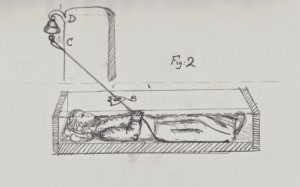My thoughts on that Russian woman who was “embalmed” alive

Ekaterina Fedyaeva
While the fear of being buried alive was a prevalent fear that had some legitimacy before the dawn of modern healthcare, today that fear — at least in countries with access to modern medical science — is unfounded. In centuries past, the fear of premature burial was so prevalent that Count Michel de Karnice-Karnicki developed a bell system that enabled someone who was buried alive to alert those above ground that there had been a ghastly mistake.

Giving farther evidence to the fact that people were prematurely buried is T.M. Montgomery, who supervised the disinterment and moving of the remains at the Fort Randall Cemetery in 1898. He reported that “nearly 2% of those exhumed were no doubt victims of suspended animation.”
While being buried alive is impossible for an embalmed body, I’ve always had this fear that I’ll pick up a deceased person, bring them back to our prep room only to discover that they are still very much alive. The fear is real enough that when I embalm someone I generally wait a minute or so after I make my first incision to see if there are any faint signs of life before I raise the artery and vein. So far, I — and every funeral director I know — have never encountered a still living supposed “corpse.”
There have been modern-day cases were someone has been prematurely pronounced dead. Here’s one such case:
Mrs Banks, 61, was found unconscious in bed after taking a drugs overdose on New Year’s Eve. She was discovered by her husband, Claude, at their home in Stonely, near Huntingdon, Cambridgeshire and subsequently pronounced dead by David Roberts, the family’s GP.
Three hours later, Ken Davison, an undertaker who knew the Banks family, saw a vein twitch and heard her snore in the mortuary at Hinchingbrooke Hospital, Huntingdon, just as he was preparing to put her in a refrigerated body tray.
But, thank goodness, Mrs. Banks was discovered alive before any attempt was made to either embalm or bury her. Because of modern healthcare, I’ve always regarded any reports of someone being “embalmed alive” with a high degree of skepticism. So when I saw this title, “Russian woman embalmed alive in deadly hospital mistake” floating around the internet, I thought it was an Onion article.
It wasn’t.
This per The Sun, “Ekaterina Fedyaeva was said to be undergoing routine surgery at a hospital in Ulyanovsk, in the Volga Federal District of Russia, when the hospital provided her on a formalin drip, which contains formaldehyde and is used to prevent corpses from decomposing.”
I’m still hoping that this is some elaborate hoax. But it doesn’t seem to be. This is a once in a billion kind of mistake that could have only been made through a confluence of poorly designed and poorly practiced medical protocols.
Here’s some more details:
“Her legs were moving, she had convulsions, her whole body was shaking,” said her mother, according to The Sun. “I put socks on her, then a robe, then a blanket but she was shivering to such an extent, I can’t even describe it.”
Her mother also said that no doctor ever checked on her after coming out of surgery.
“This is pure murder,” said Galina Baryshnikova, according to reports. “[It] was simply eroding her body from inside.”
She said she begged doctors to help but they told her to go home.
“For 14 hours after surgery she was living with this formalin and they did nothing,” she said.
She said a doctor eventually admitted to the blunder but did not specifically reveal the cause of her condition.
Fedyaeva was later transported to a hospital in Moscow, where she ultimately died. A criminal investigation into the cause of her death is said to be underway. — Fox 32
Pure formalin is a much strong solution that the embalming fluid we use on dead bodies.
Formaldehyde is a naturally occurring gas that is highly dissolvable in water. When it is dissolved in water, it’s called “formalin”, which is the liquid that was intravenously given to Ekaterina. Formalin is 40% formaldehyde.
Embalming fluid is rated by formaldehyde index: strong embalming fluid has an index of 28% to 36%, medium fluid has an index of 19% to 27%, and weak fluid is 10% to 18% index. Even our strongest embalming fluid has less formaldehyde than pure formalin, and even much less when we mix the embalming fluid with water.
After we mix the embalming fluid with water, the solution has a much lower amount of formaldehyde, often around 2%. In other words, what was injected into Ekaterina — if it was formalin with 40% formaldehyde — could have been up to 20 times stronger than the embalming fluid I would use in my prep room.
With arterial fluid that is 2%, I can effectively harden and preserve most cases. This is how it happens: “Formaldehyde or glutaraldehyde fixes tissue or cells by irreversibly connecting a primary amine group in a protein molecule with a nearby nitrogen in a protein or DNA molecule through a -CH2- linkage called a Schiff base” (Wikipedia). To put it simply: formaldehyde literally rips apart tissue on a molecular level.
A slow, intravenous drip of formalin would have ripped apart the insides of Ekaterina Fedyaeva. This is absolutely torturous. The stuff of nightmares.
From what I’m reading it seems that Ekaterina wasn’t conscious during this travesty. I can only hope that was indeed the case.
****
Consider supporting my work by buying my book, “Confessions of a Funeral Director.” Click the picture below to read more:
Via Funeral http://www.rssmix.com/
Comments
Post a Comment